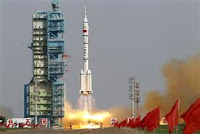The Kennedy Space Center , based in Florida (USA) from which the great deceased NASA's manned missions, this year celebrates its 50th anniversary in lean times of low activity. Of its two launch pads in an area of marsh flat, ideal for spacecraft and satellites send their position in the southern U.S. and the vast Atlantic Ocean to the east, left the astronauts who went to the moon and all ferry for three decades. Now are not used and are awaiting that need new rockets NASA plans for five or six years at the earliest.
Last week a rocket lifted off from Florida Falcon-9 with the new automatic load ship Dragon , SpaceX company, but he did it from the nearby Air Force base at Cape Canaveral, from which rockets are launched regularly Atlas and Delta of unmanned exploration missions, as well as military devices, communication satellites and scientific observatories. Kennedy Space Center (KSC, its acronym in English) has lost a lot of activity since it landed there almost a year ago, Atlantis on last mission of these spacecraft, now converted into museum pieces.
"While we are transitioning from the shuttle program to future employers, the workforce remains dedicated to Kennedy's core values NASA: security, integrity, teamwork and excellence," says its director, Robert Cabana. "We will continue to support the operations of the International Space Station at the entrance of the laboratory [...] and we are working together with trading partners to make them a reality for future missions," continues this exastronauta email.
With the end of the ferries have lost almost 9,000 jobs (out of 17,000 in the period of maximum activity) at KSC, including personnel from NASA and the space business which was outsourced much of the work of that program. For many, the current situation is reminiscent of the KSC who lived between the end of the Apollo program (1972) and tore the ferries. All missions of these ships (135 in total between 1981 and 2011) started from the two KSC launch pads and most of them landed in the track of 4.6 kilometers in length.
In facilities now are still working, but much less than a few years ago. Is finalizing preparations for missions departing from the neighboring base of Cape Canaveral, logistics operations are the ISS and continue tracking the spacecraft. But the astronauts at NASA headquarters in Houston (Texas) and travel into space from Baikonur (Kazakhstan) in the Russian spacecraft Soyuz. The gigantic buildings preparation of rockets and spacecraft at KSC, some of them built for the Apollo program and utilized for ferries have been deprecated.
A popular visitor center at KSC and a hangar that houses, a museum, one of the last Saturn V rocket that came from, still open at KSC.
A couple of years still hoped to avoid this crossing the desert to the NASA base in Florida, with the Constellation program, which was to develop two new rockets: Ares I and Ares V. The large From the first it was even successfully run a test at KSC, reforming to do one of two launch pads, the 39B. But the Constellation was canceled and NASA now opt to private vehicles for the exploitation of the ISS, while designing an ambitious new Space Launch System (SLS, in English).
The plan is to develop a heavy rocket, using parts of the ferries and technologies with several possible configurations to launch from 70 to 130 tons of cargo. These rockets will carry astronauts to space vehicles, modules and equipment for missions beyond Earth orbit, ie, the moon, an asteroid and perhaps to Mars.





No comments:
Post a Comment